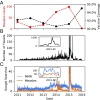Critical dynamics in population vaccinating behavior
- PMID: 29229821
- PMCID: PMC5748162
- DOI: 10.1073/pnas.1704093114
Critical dynamics in population vaccinating behavior
Abstract
Vaccine refusal can lead to renewed outbreaks of previously eliminated diseases and even delay global eradication. Vaccinating decisions exemplify a complex, coupled system where vaccinating behavior and disease dynamics influence one another. Such systems often exhibit critical phenomena-special dynamics close to a tipping point leading to a new dynamical regime. For instance, critical slowing down (declining rate of recovery from small perturbations) may emerge as a tipping point is approached. Here, we collected and geocoded tweets about measles-mumps-rubella vaccine and classified their sentiment using machine-learning algorithms. We also extracted data on measles-related Google searches. We find critical slowing down in the data at the level of California and the United States in the years before and after the 2014-2015 Disneyland, California measles outbreak. Critical slowing down starts growing appreciably several years before the Disneyland outbreak as vaccine uptake declines and the population approaches the tipping point. However, due to the adaptive nature of coupled behavior-disease systems, the population responds to the outbreak by moving away from the tipping point, causing "critical speeding up" whereby resilience to perturbations increases. A mathematical model of measles transmission and vaccine sentiment predicts the same qualitative patterns in the neighborhood of a tipping point to greatly reduced vaccine uptake and large epidemics. These results support the hypothesis that population vaccinating behavior near the disease elimination threshold is a critical phenomenon. Developing new analytical tools to detect these patterns in digital social data might help us identify populations at heightened risk of widespread vaccine refusal.
Keywords: early warning signals; machine learning; online social media; socioecological systems; vaccine refusal.
Copyright © 2017 the Author(s). Published by PNAS.
Conflict of interest statement
The authors declare no conflict of interest.
Figures





References
-
- Omer SB, Orenstein WA, Koplan JP. Go big and go fast—vaccine refusal and disease eradication. N Engl J Med. 2013;368:1374–1376. - PubMed
-
- California Department of Public Health 2017 Kindergarten immunization levels. Available at http://www.shotsforschool.org/k-12/reporting-data/. Accessed February 4, 2016.
-
- Zipprich J, et al. 2015 Measles outbreak—California, December 2014–February 2015. MMWR Morb Mortal Wkly Rep 64:153–154. Available at https://www.cdc.gov/mmwr/preview/mmwrhtml/mm6406a5.htm. Accessed November 20, 2017.
Publication types
MeSH terms
Substances
LinkOut - more resources
Full Text Sources
Other Literature Sources

